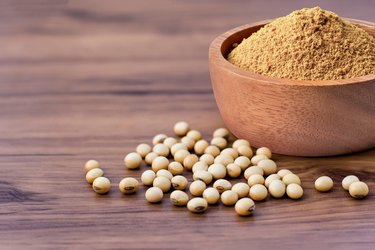
The soybean is a versatile food that is used to produce soy milk, various sauces, tempeh, tofu, miso paste and much more. Soy products are commonly used as a substitute for meat by vegetarians and vegans, as well as omnivores who appreciate the taste and nutritional profile of soy. Soy is high in protein, amino acids, fiber, vitamin B and omega-3 fatty acids, which results in many added health benefits such as lower cholesterol levels. Soybean-based products that are a little less familiar to most include soy flour, aka soya flour, and soya powder, aka soy powder. These ingredients are often added to baked goods to increase their nutritional value, and they boast a wide variety of valuable culinary applications.
What is Soya Powder?
Video of the Day
To make soya powder, or soy powder, soybeans are first washed in water, then cooked in steam at a temperature of 215 degrees Fahrenheit. The hulls are removed before the remaining parts of the soybean are ground into a fine powder. Soya powder has a subtle flavor which makes it a versatile ingredient to add to many baked goods recipes. The powder is also used in the production of soy milk.
Video of the Day
Depending on how it is processed, soya powder is also known as a protein powder that can be used in protein shakes along with other ingredients. This type of soya powder does not mix well with water and can cause flatulence in sensitive individuals, but its health benefits make up for the disadvantages. Include soya protein powder in your diet and the antioxidants may help reduce your risks of heart disease, breast cancer, prostate cancer and osteoporosis.
What is Soy Flour?
Soy flour is made from whole dry soybeans by grinding them into a flour which can then be left as is for raw soy flour, or toasted to be used in baking recipes. When used in baked goods, soy flour is often mixed with other types of flours and is best used in recipes in which a nutty flavor is preferred. This type of flour is much higher in protein than regular flour, making it an easy way to add nutritional value to your diet. In baked goods, soy flour can also increase the storage life of your food.
Soya Powder vs Soy Flour: Similarities
Both soya powder and soy flour are derived from soybeans, making them very popular sources of protein that are easy to mix into a variety of recipes such as baked goods, pastas, smoothies and meats dishes. The low cost of soybeans has made soy powder and soy flour a choice during wartime and famine for people in need of foreign relief or refugee food programs.
Soya Powder vs Soy Flour: Differences
The major difference between these soy products is that in the powder the hulls are removed as part of the process while the flour is made using the whole soybean. To produce the powder, the soybean is cooked before grinding; in the flour, the soybean may or may not be cooked, and is done so after being ground into a fine powder. This difference in production means that soya powder is finer than soy flour and its flavor is usually more pronounced. Soy flour is easy to find in most grocery store of health food stores, but soya powder can be harder to find. You may have a better chance finding soya powder online or in specialty health food or supplement stores.